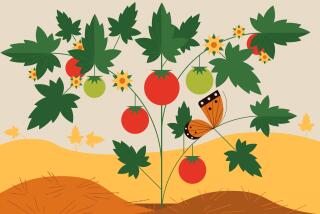Non-Bearing Tomatoes May Require More Sun
QUESTION: I planted a “Burpee Big Girl Tomato” plant in a large pot on our patio. It receives west sun from 2 or 3 o’clock until sundown. Nice tall plant--many blooms--but no tomatoes. Water every two or three days. What’s wrong?
ANSWER: Not enough sun. Most tomatoes, especially large ones like Big Girl, won’t fruit with that limited amount of sunlight. Provide a sunnier location, or next year plant a smaller tomato variety--one that is designed for container growing, such as Patio.
Trim Plumeria During Its Dormant Period
Q: When and how do you prune plumeria? Mine is about 10 feet high with some branches extending six feet into my yard. Help!
A: Any major pruning of plumeria should be done when the plant is dormant (when all the leaves have fallen and there are no signs of new growth). The usual dormant period occurs from early to mid-winter. However, you can make a moderate trimming of plumeria anytime.
They’re Different but Both Are Berry Good
Q: Local restaurants carry both boysenberry and olallieberry pies when they are in season. What is the difference between the two berries?
A: The boysenbery is a cross between a blackberry, a raspberry and a loganberry. An olallieberry is a cross between a youngberry and a loganberry. I have grown both, and in my opinion, the olallieberry has more of a wild berry flavor; the boysenberry, while somewhat tart, is sweeter than the olallieberry. Both are good eaten fresh and they make excellent pies. Both berries grow well in most regions of the Southland.
Hiker Attracted by Wild Lilac Flowers
Q: I am an avid hiker and each year, while hiking the foothills in March, I observe large shrubs completely covered with white, lavender, purple or pink flowers. What is the name of these shrubs and can I grow them in my yard?
A: The shrubs are Ceanothus (wild lilac) and they will adapt to local landscaping situations if they are placed in an area where they will not receive too much water. If used as lawn plants, they will succumb to soil fungus diseases.
These beautiful evergreen plants are quite drought-tolerant and must be grouped in a landscape with other drought-tolerant plants. Ceanothus is one of the handsomest of the California natives and comes in a number of species. Ceanothus can be found in local nurseries in early fall.






